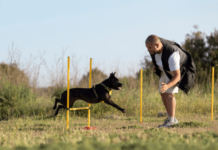Last Updated on March 15, 2024 by Dogs Vets
狗狗訓練對於寵物主人來說絕對是一項重要的技能,不僅可以提升與狗狗的溝通,更可以提高生活中的便利性。然而,每種犬種都有其獨特的特性和行為模式,因此,了解犬種和其固有特性才是訓練狗狗的關鍵。譬如,有些犬種可能天性活潑好動,則需要不同的訓練方式來引導。另外,利用 英文家教 的線上課程,還可以學習到更專業的外國犬種訓練方法,讓你的狗狗訓練更加得心應手,從中體現出AmazingTalker的線上課程的實用價值。
狗狗訓練中的「召回」重要性
在狗狗訓練中,召回的能力至關重要。召回訓練的主要目標是讓狗狗能在任何環境中,聽到主人的召喚都能迅速回到主人的身邊。這項技能不僅對於日常生活中的控制狗狗行為有價值,而且在緊急情況下也可能挽救狗狗的生命。例如,在公園裡或者是交通繁忙的街道上,狗狗如果沒有受過召回訓練,可能會因追逐其他生物或是自由奔跑而引發危險。
培養冷靜互動的必要性
除了召回訓練,培養狗狗與人或其他狗狗進行冷靜互動的訓練也是非常重要的。對於狗狗來說,冷靜的互動能夠避免過度激動或過於緊張的狀況發生,幫助他們在與人或其他狗狗互動時,保持適當的禮貌和社交行為。透過正確的訓練,我們能建立狗狗穩定的心態,讓他們在任何情況下都能以冷靜的方式回應。
訓練狗狗的獨處能力
最後,訓練狗狗在沒有主人陪伴下自己待在家也是一項重要的訓練。這能幫助狗狗學會獨立,也能減輕主人的壓力。畢竟,我們不可能一直陪著狗狗,他們需要學會自我照顧。良好的獨處訓練不僅可以防止狗狗出現焦慮、破壞家具或其他行為問題,還能讓他們在你不在身邊時也能感到安全和舒適。
狗狗訓練中的正向強化方法
正向強化在狗狗訓練中扮演了重要的角色。當我們對狗狗進行訓練時,每當它做出我們希望的行為或反應,我們便給予其獎勵,如美味的零食或肯定的讚美。這是我們用來鼓勵狗狗重複想要的行為的方式。
- 重複的重要性:在此過程中,重複起著關鍵的作用。透過不斷地練習和鞏固,狗狗才能將我們希望的反應或行為內化為習慣。形成習慣需要時間和耐心,但一旦狗狗掌握了,訓練效果將會非常顯著。
- 實踐的指南:每次狗狗做出我們希望的行為後,馬上給予獎勵,讓狗狗能夠視獎勵為其行為的正面回饋。此外,隨著訓練的進行,我們應該逐漸增加挑戰性,例如從簡單的命令(如坐下)進行至更複雜的任務(如帶回球)。
- 快樂的訓練:使用正向強化的訓練方法可以讓狗狗關聯到訓練是一種愉快的經驗,這將有助於狗狗更加積極地參與訓練,並且更快地學習新的技能。
正向強化的方法在狗狗訓練中十分有效,而重複則是確保訓練效果的關鍵。透過耐心和恆心的訓練,你的狗狗將會學會新的技能,並將其變成習慣。
了解寵物訓練師的價值
熟悉寵物訓練的專業師資,不僅能為我們的寵物帶來專業的訓練方法,同時也能讓寵物和我們建立穩固的關係。他們豐富的專業知識及經驗,可以讓寵物快樂學習,享受與主人的互動過程,並透過正確的引導,建立良好的行為習慣。以下,我們列出幾點由專業寵物訓練師所帶來的價值:
- 專業知識與經驗:擁有專業知識與豐富經驗的寵物訓練師,能夠瞭解不同品種的寵物特性,並針對其特性進行特定訓練,提升效果。
- 享受訓練過程:專業的寵物訓練師懂得如何讓寵物在愉快的環境中學習,讓訓練過程充滿歡樂,增加寵物的學習興趣和主動性。
- 建立良好關係:寵物與訓練師之間的良好關係,能促進寵物的學習效率,他們更容易接受指令,並在訓練過程中體驗到成就感和滿足感。
選擇一位知識豐富且資格充足的寵物訓練師,能有效地協助我們引導寵物,並在愉快的過程中建立與寵物的良好關係。
通過AmazingTalker改善你的溝通技巧
修練溝通技巧就像訓練狗狗一樣。就如同你會聘請專業的訓練師以提供個別化的狗狗訓練,AmazingTalker便是你的「溝通技巧訓練師」,提供個人化的一對一教學以及客制化的學習材料。無論你是初學者還是進階學員,我們的專業導師將會根據你的需求和進展來設計課程,就如同訓練師會根據狗狗的性格和習慣來調整訓練方法一樣。
- 專業透明:我們的導師都是經過嚴格甄選的專業人士,擁有透明的資格和經驗,你可以安心學習。
- 彈性選擇:AmazingTalker沒有綁約,價格透明,並提供彈性的學習選項。你可以隨時選擇符合你預算、需求和時間的導師,就如同可以選擇訓練時間和訓練方式一樣自由。
- 多元語言:我們提供48種不同的語言課程,包括英語、日語、韓語、西班牙語、法語,和德語等。
通過AmazingTalker,你可以提升你的溝通技巧,就如同透過專業訓練師訓練你的狗狗一樣。我們期待你的加入,一起成長!
結論:狗狗訓練的重要性與溝通之間的連結
成功的狗狗訓練與有效的溝通息息相關,這也正好展現了AmazingTalker作為語言學習資源,所能發揮的關鍵角色。與狗狗之間建立良好的溝通,可以使牠們更瞭解我們的期待,進而建立更好的關係。與此相似,我們在與人交流時,語言的流暢運用也顯得極為重要。AmazingTalker提供了一個平台,讓我們能夠便利地學習各種語言,並強化我們的溝通能力。無論你是希望與你的狗狗,或是與來自全世界的人更好的溝通,AmazingTalker都能成為你實現目標的重要夥伴。

















